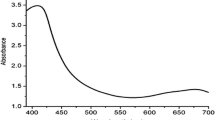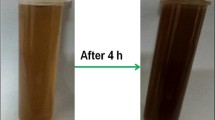Abstract
The present study reports the biological synthesis of silver and gold nanoparticles from Gymnema sylvestre leaf extract and their in vitro free radical scavenging efficacy as well as antiproliferative effect in Hep2 cells. The formation of silver (GYAgNPs) and gold nanoparticles (GYAuNPs) was confirmed by UV–visible spectroscopy. The average size of synthesized GYAgNPs and GYAuNPs was found to be 33 and 26 nm, respectively, by DLS particle size analyzer. TEM analysis indicated spherical shape of GYAgNPs and GYAuNPs and in EDX analysis they produced strong signal for silver and gold, respectively. Both GYAgNPs and GYAuNPs exhibited strong in vitro free radical quenching ability and their activity was comparable to that of GYLE. The cytotoxic effect of GYAgNPs and GYAuNPs in Hep2 cells was examined by MTT assay in which GYAgNPs displayed an IC50 value of 121 µg ml−1, while GYAuNPs produced up to 38 % of inhibition at the maximum concentration of 250 µg ml−1 used in this study. Distinct morphological changes were observed in Hep2 cells following treatment with GYAgNPs and GYAuNPs at 24 h, and orange-colored apoptotic bodies were located by acridine orange and ethidium bromide double-staining technique. Also, there was increase in the levels of reactive oxygen species in treated cells as indicated by 2′,7′-dichlorofluorescin diacetate staining. Further, nuclear changes like chromatin condensation/fragmentation were also observed by propidium iodide and 4′,6-diamidino-2-phenylindole dilactate staining methods. These findings support that the antiproliferative effects of GYAgNPs and GYAuNPs in Hep2 cells are mediated through induction of apoptosis.










Similar content being viewed by others
References
Basavegowda N, Idhayadhulla A, Lee YR (2014) Phyto-synthesis of gold nanoparticles using fruit extract of Hovenia dulcis and their biological activities. Ind Crops Prod 52:745–751
Chandran SP, Chaudhary M, Pasricha R, Ahmad A, Sastry M (2006) Synthesis of gold and silver nanoparticles using aloe vera plant extract. J Biotechnol Prog 22:577–583
Chang W, Choi SCK, Soon SH, Bong KC, Hye JA, Min YL, Sang HP, Soo KK (2002) Antioxidant activity and free radical scavenging capacity between Korean medicinal plants and flavonoids by assay guided comparison. Plant Sci 163:1161–1168
Das S, Das J, Samadder A, Bhattacharyya SS, Das D, Khuda-Bukhsh AR (2013) Biosynthesized silver nanoparticles by ethanolic extracts of Phytolacca decandra, Gelsemium sempervirens, Hydrastis canadensis and Thuja occidentalis induce differential cytotoxicity through G2/M arrest in A375 cells. Colloids Surf B Biointerf 2013(101):325–336
Dipankar C, Murugan S (2012) The green synthesis, characterization and evaluation of the biological activities of silver nanoparticles synthesized from Iresine herbstii leaf aqueous extracts. Colloids Surf B Biointerf 98:12–119
Esumi K, Tano T, Torigoe K, Meguro K (1990) Preparation and characterization of biometallic Pd–Cu colloids by thermal decomposition of their acetate compounds in organic solvents. J Chem Mater 2:564–567
Ferlay J, Parkin DM, Pisani P (2004) GLOBOCAN 2002: cancer incidence, mortality and prevalence worldwide. IARC, Lyon, France
Forough Mehrdad, Farhadi Khalil (2010) Biological and green synthesis of silver nanoparticles. Turkish J Eng Env 34:281–287
Garatt DC (1964) The quantitative analysis of drugs, 2nd edn. Chapman and Hall, Tokyo
Grover JK, Yadav S, Vats V (2002) Medicinal plants of India with anti-diabetic potential. J Ethnopharmacol 81(1):81–100
Henglein A (1998) Colloidal silver nanoparticles: photochemical preparation and interaction with O2, CCl4, and some metal ions. J Chem Mater 10:444–446
Huie RE, Padmaja S (1993) The reaction of NO with superoxide. Free Radic Res Commun 18:195–199
Iravani S (2011) Green synthesis of metal nanoparticles using plants. Green Chem 13:2638
Jae YS, Beom SK (2009) Rapid biological synthesis of silver nanoparticles using plant leaf extracts. Bioprocess Biosyst Eng 32:79–84
Jeyaraj M, Rajesh M, Arun R, MubarakAli D, Sathishkumar G, Sivanandhan G, Kapil Dev G, Manickavasagam M, Premkumar K, Thajuddin N, Ganapathi A (2013) An investigation on the cytotoxicity and caspase mediated apoptotic effect of biologically synthesized silver nanoparticles using Podophyllum hexandrum on human cervical carcinoma cells. Colloids Surf B Biointerf 102:708–717
Kanipandian N, Thirumurugan R (2014) A feasible approach to phyto-mediated synthesis of silver nanoparticles using industrial crop Gossypium hirsutum (cotton) extract as stabilizing agent and assessment of its in vitro biomedical potential. Ind Crop Prod 55:1–10
Klaus T, Joerger R, Olsson E, Granqvist CG (1999) Silver-based crystalline nanoparticles, microbially fabricated. Proc Natl Acad Sci 96:13611–13614
Kumar KM, Sinha M, Mandal BK, Ghosh AR, Kumar KS, Reddy PS (2012) Green synthesis of silver nanoparticles using Terminalia chebula extract at room temperature and their antimicrobial studies. Spectrochim Acta A Mol Biomol Spectrosc 91:228–233
Leach SJ, Scheraga HA (1960) Effect of light scattering on ultraviolet difference spectra. J Am Chem Soc 82:4790–4792
Liz-Marzan LM, Lado-Tourino I (1996) Reduction and stabilization of silver nanoparticles in ethanol by nonionic surfactants. Langmuir 12:3585–3589
Makari HK, Haraprasad N, Patil HS, Ravi K (2008) In vitro antioxidant activity of the hexane and methanolic extracts of Cordia wallichii and Celastrus paniculata. Internet J Aesthet Antiaging Med 1:1–10
Mosmann T (1983) Rapid colorimetric assay for cellular growth and survival: application to proliferation and cytotoxicity assays. J Immunol Methods 65:55–63
Nair B, Pradeep T (2002) Coalescence of nanoclusters and formation of submicron crystallites assisted by Lactobacillus strains. Cryst Growth Des 2:293–298
Nakkala JR, Mata R, Gupta AK, Sadras SR (2014) Biological activities of green silver nanoparticles synthesized with Acorous calamus rhizome extract. Eur J Med Chem 85:784–794
Nishikimi M, Appaji N, Yagi K (1972) The occurrence of superoxide anion in the reaction of reduced phenazine methosulfate and molecular oxygen. Biochem Biophys Res Commun 46:849–854
Noginov MA, Zhu G, Bahoura M, Adegoke J, Small C, Ritzo BA, Drachev VP, Shalaev VM (2006) The effect of gain and absorbance on surface Plasmon in metal nanoparticles. Appl Phys B 86:455–460
Pacher P, Beckman JS, Liaudet L (2007) Nitric oxide and peroxynitrite in health and disease. Physiol Rev 87:315–424
Patel Avani, Patel Amit, Patel Amit, Patel NM (2010) Determination of polyphenols and free radical scavenging activity of Tephrosia purpurea linn leaves (Leguminosae). Pharmacogn Res 2:152–158
Patel K, Gadewar M, Tripathi R (2012) Pharmacological and analytical aspects of gymnemic acid: a concise report. Asian Pac J Trop Dis 2:414–416
Percival M (1998) Antioxidants. Clin Nutr Insights 31:1–4
Philip D, Unni C, Aromal SA, Vidhu VK (2011) Murraya koenigii leaf-assisted rapid green synthesis of silver and gold nanoparticles. Spectrochim Acta A Mol Biomol Spectrosc 78:899–904
Prabhu D, Arulvasu C, Babu G, Manikandan R, Srinivasan P (2013) Biologically synthesized green silver nanoparticles from leaf extract of Vitex negundo L. induce growth-inhibitory effect on human colon cancer cell line HCT15. Process Biochem 48:317–324
Reddy NJ, Nagoor Vali DN, Rani M, Rani SS (2014) Evaluation of antioxidant, antibacterial and cytotoxic effects of green synthesized silver nanoparticles by Piper longum fruit. Mater Sci Eng C Mater Biol Appl 34:115–122
Reed JC (1999) Mechanisms of apoptosis avoidance in cancer. Curr Opin Oncol 11:68–75
Sudjaroen Y (2009) Plant-derived phenolic antioxidants and cancer prevention. Thai Cancer J 29:126–134
Sun YP, Atorngitjawat P, Meziani MJ (2001) Preparation of silver nanoparticles via rapid expansion of water in carbon dioxide microemulsion into reductant solution. Langmuir 17:5707–5710
Tiwari P, Mishra BN, Sangwan NS (2014) Phytochemical and pharmacological properties of Gymnema sylvestre: an important medicinal plant. Biomed Res Int 2014:1–18
Vigneshwaran N, Ashtaputre NM, Varadarajan PV, Nachane RP, Paraliker KM, Balasubramanya RH (2007) Biological synthesis of silver nanoparticles using the fungus Aspergillus flavus. Mater Lett 61:1413–1418
Vivek R, Thangam R, Muthuchelian K, Gunasekaran P, Kaveri K, Kannan S (2012) Green biosynthesis of silver nanoparticles from Annona squamosa leaf extract and it’s in vitro cytotoxic effect on MCF-7 cells. Process Biochem 47:2405–2410
Willner I, Baron R, Willner B (2006) Growing metal nanoparticles by enzymes. J Adv Mater 18:1109–1120
Acknowledgments
The authors acknowledge the DST, Government of India, New Delhi, for financial support in the form of DST-FIST. The authors thank DBT-IPLS (BUILDER) program for Fluorescence microscope facility and the Central Instrumentation Facility (CIF), Pondicherry University. The first author (J. R. Nakkala) conveys special thanks to CSIR, India for the financial assistance in the form CSIR-JRF.
Author information
Authors and Affiliations
Corresponding author
Electronic supplementary material
Below is the link to the electronic supplementary material.
Rights and permissions
About this article
Cite this article
Nakkala, J.R., Mata, R., Bhagat, E. et al. Green synthesis of silver and gold nanoparticles from Gymnema sylvestre leaf extract: study of antioxidant and anticancer activities. J Nanopart Res 17, 151 (2015). https://doi.org/10.1007/s11051-015-2957-x
Received:
Accepted:
Published:
DOI: https://doi.org/10.1007/s11051-015-2957-x




